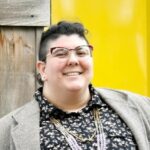
Alexandra Mannerings: Increase Data Literacy Across Your Nonprofit
 Widespread data literacy helps your teams build a shared language of data communication, recognize good and bad data, and appropriately apply analytics to improve decision making. Alexandra Mannerings makes the case. She’s from Merakinos. (This is part of our continuing #22NTC coverage.)
Widespread data literacy helps your teams build a shared language of data communication, recognize good and bad data, and appropriately apply analytics to improve decision making. Alexandra Mannerings makes the case. She’s from Merakinos. (This is part of our continuing #22NTC coverage.)
Listen to the podcast
Podcast: Play in new window | Download
Get Nonprofit Radio insider alerts!
I love our sponsors!
![]() Turn Two Communications: PR and content for nonprofits. Your story is our mission.
Turn Two Communications: PR and content for nonprofits. Your story is our mission.
Fourth Dimension Technologies: IT Infra In a Box. The Affordable Tech Solution for Nonprofits.
We’re the #1 Podcast for Nonprofits, With 13,000+ Weekly Listeners
Board relations. Fundraising. Volunteer management. Prospect research. Legal compliance. Accounting. Finance. Investments. Donor relations. Public relations. Marketing. Technology. Social media.
Every nonprofit struggles with these issues. Big nonprofits hire experts. The other 95% listen to Tony Martignetti Nonprofit Radio. Trusted experts and leading thinkers join me each week to tackle the tough issues. If you have big dreams but a small budget, you have a home at Tony Martignetti Nonprofit Radio.
View Full Transcript
Processed on: 2022-08-06T00:34:50.783Z
S3 bucket containing transcription results: transcript.results
Link to bucket: s3.console.aws.amazon.com/s3/buckets/transcript.results
Path to JSON: 2022…08…603_tony_martignetti_nonprofit_radio_20220808.mp3.532593779.json
Path to text: transcripts/2022/08/603_tony_martignetti_nonprofit_radio_20220808.txt
[00:01:50.98] spk_0:
And welcome to Tony-Martignetti non profit radio big non profit ideas for the other 95%. I’m your aptly named host of your favorite abdominal podcast. Oh I’m glad you’re with me, I’d be hit with mega low kyra if you handed me the idea that you missed this week’s show increased data literacy across your non profit widespread data literacy helps your teams build a shared language of data, communication, recognize good and bad data and appropriately apply analytics to improve decision making. Alexandra manna Rings makes the case she’s from Morocco knows This is part of our continuing 22 and T. c. coverage on Tony’s Take to Tiktok we’re sponsored by turn to communications pr and content for nonprofits. Your story is their mission turn hyphen two dot C. O. And by fourth dimension technologies I. T. Infra in a box. The affordable tech solution for nonprofits tony-dot-M.A.-slash-Pursuant D just like three D but they go one dimension deeper here is increased data literacy across your non profit Welcome to tony-martignetti non profit radio coverage of 22 N. T. C. You know what it is? It’s the 2022 nonprofit technology conference, you know that it’s hosted by N 10. My guest now in our coverage is Alexandra Mana Rings, founder of Morocco knows Alexandra Welcome to non profit radio
thank you so much for, having me here today tony quite [00:02:04.37] spk_0:
a pleasure Absolutely welcome for your first your first time maybe first time lets see [00:02:10.11] spk_1:
Yeah it’s my first time with NtC. So [00:02:12.68] spk_0:
oh, is it okay? I go back to 2015 or something. I’ve been doing interviews from NtC used to do them when, when it was an in person conference, I did them live on the uh on the exhibit floor. Oh, [00:02:25.70] spk_1:
that’s fun. Maybe someday we’ll get back to their [00:02:27.60] spk_0:
next year is supposed to be next year in Denver, it’s supposed to be [00:02:31.09] spk_1:
well, perfect. Because I’m already in Denver, [00:02:34.26] spk_0:
fingers crossed. Is that where you are? Oh [00:02:36.80] spk_1:
well [00:02:40.79] spk_0:
NtC is gonna be local to you. There you go. Save your savior, save the cost of a hotel [00:02:43.06] spk_1:
room stay. [00:02:44.65] spk_0:
Actually, people people, people who are local state because it’s so much fun up till like 9 30 10 o’clock at night, they don’t really want to be like driving home, rather just take an elevator home, you know, to their room. So consider that possibility too. All right, [00:03:00.57] spk_1:
your [00:03:08.94] spk_0:
session is the imperative to increase data literacy across your organization. Why is this important? Help us understand overview [00:03:12.62] spk_1:
Why [00:03:12.93] spk_0:
does this matter for everybody in the organization. [00:05:36.37] spk_1:
I feel that data literacy matters for two critical reasons. The first is because it is very difficult to get through your professional life efficiently and effectively, if you are not data literate. And the second reason is it’s very difficult to get through your personal life if you are not data literate. And the reason that I believe this is because data literacy is a subset of literacy, we wouldn’t, we would imagine that getting through life if you weren’t literate. If you couldn’t read or write to be nearly impossible. And data literacy is the same thing. I think we get confused with data literacy because we think it means only the production of data products, right? We think that this means I have to be someone who can create those fancy graphs, build data models, be a data engineer, create data warehouses and that’s just a tiny component of data literacy. I joke that you wouldn’t say you weren’t literate if you couldn’t read Hebrew or you weren’t reading, you know dostoyevsky, that’s a very subset of literacy that is reserved for specialists. Same with reading a medical textbook. Sure there is technical literacy that’s needed if you work in very specific technical rules. But we expect the rest of us to be able to read at a certain functional level and we should expect that we can use data at a certain functional level. And the reason for this is that so many things use data literacy that I don’t think we ran recognize are actually data literacy tasks. For example, you go to the grocery store and you see two different items that are different sizes and you need to decide which one do I buy and one is priced at 2 49 1 is priced at 3 15. You’ve got to compare across different situations, different context of those numbers and decide what’s the right one using the values of what you need to actually get done. That’s literacy. Exactly. That’s arithmetic. Or write another example with data literacy um is also understanding how our brains function with numbers. So you go to buy an item, right? And you see the little strike strikeout number was like used to be 9 99 and now it’s 3 49 or whatever. And that leverages a technique called anchoring by exposing us to a higher value number were more inclined to think that the lower value number is a better deal than we would have had. We just seen the original that that actual price, [00:05:48.88] spk_0:
we’ve just [00:06:06.27] spk_1:
seen 3 49 right? We would respond differently to that foreseen 3 49 against a previous 9 99 price. And so part of data literacy is also being aware of how we as humans ingest and interact with numbers and we have to deal with those kinds of things all the time. And then I [00:06:07.40] spk_0:
have an example. I share an example with [00:06:09.53] spk_1:
you. I [00:06:39.33] spk_0:
remember I thought so fascinating menus in restaurants, people will perceive a number with a dollar sign in front of it to cost more than if the price in the menu is written out. No, no, there’s no Arabic numbers, it’s written out 12 $12.12 dollars 50 cents. That’s written versus dollar sign 12.50. Because you don’t think of, you don’t think of the written out as money. It’s not something out of your pockets, not something you have to spend. It’s just, it’s just an abstract word, $12.50 or abstract words. I thought that was fascinating. [00:07:24.83] spk_1:
And there’s so many things like that where because we’re humans and the way that our brains work, we have all these shortcuts that allow us to do these extraordinary things that computers are still trying to catch up to. But it also means that occasionally those shortcuts have these odd side effects and these sorts of things like anchoring are some of those odd side effects and being aware of them can help you not be misled by people who might try to to use that against you. And then sorry, go ahead. [00:07:27.30] spk_0:
Remember my question. I [00:08:05.40] spk_1:
was gonna say as well that another part of data literacy is being able to be appropriately skeptical of the numbers that you see around you, right. You don’t necessarily have to know how to produce those numbers. You don’t have to know how to calculate those sorts of things, but you do need to you know when you should trust numbers and when you should maybe ask a few more questions about where those numbers came from. And in order to be able to be effectively skeptical rather than just either say I won’t trust numbers because you can’t trust numbers, blanket statement or being other. Your other option is that you just have to go entirely based on who’s giving it to you and that can, can be helpful. It can be a decent shortcut. But you want to be able to actually look at each number in each case and say, you know what might be some shortcomings of this number or what else might I need to do to really understand how I could apply this number. Understanding the limitations of the data that it came from. [00:08:22.98] spk_0:
All right. You need to be able to react in individual cases. [00:08:26.77] spk_1:
Yeah. When [00:08:44.81] spk_0:
when you’re seeing numbers right. All right. You need to give your cat some love the second time up on your lap. I saw she was very you couldn’t even to listeners. You couldn’t even tell. But she gave the cat a couple of strokes. Put it down and came right back. That wasn’t enough. Not not even close. All right. Um Do you have a background in in data science or in any something quantitative? [00:09:15.49] spk_1:
I joke that I’m a scientist who works with data rather than a data scientist. Data scientist is a a fuzzy term. Um But for the most part, a lot of people interpret it to mean having a lot of technical skills coding, data engineering. But my background is actually in life science. I have a PhD in epidemiology. I studied spillover of pathogens from fruit bats into people in West africa for my PhD. So I say that that gives me a really good way of asking questions of numbers and all of my quantitative skills have come out of. How do I actually process information to get me the scientific answers that I was looking for? [00:09:29.69] spk_0:
How did you get from spillover fruit bats in western Western africa? Yeah, [00:09:35.03] spk_1:
I wasn’t gonna [00:09:36.15] spk_0:
non profit to the nonprofit technology conference, [00:09:40.04] spk_1:
God blessed the broken road rascal flatts. [00:09:43.25] spk_0:
So [00:09:51.56] spk_1:
life, life has funny things. Um, I guess the shorthand of it is I was intending to go into global public health. It was where my passion was very, very interested in, especially in the space of zoonotic disease. So things that go from animals into people which now we’re all very aware [00:09:59.87] spk_0:
of coronavirus is [00:10:01.02] spk_1:
right. Exactly. [00:10:02.84] spk_0:
We, aside from conspiracy theories is very reputable. E deemed to have emerged from [00:10:13.43] spk_1:
Yes, yes, no, coronavirus as we know are have, uh, they’re the reservoir for most coronavirus is, But yeah. And so that didn’t end up working out quite the way that I wanted. And so I found myself through a number of different things here. And I am very glad I did. I enjoy it. Very, very much good. [00:11:02.27] spk_0:
We’re glad to have you. My law career didn’t work out very well and here I am nonprofits, fundraising and podcasting. So all right. So that seems like enough motivation hopefully for folks. How do we start to get um, everybody in the organization, I mean, you said everybody can do better with data literacy in their jobs than without. So how do we get this to trickle down to folks that may believe that their work, it’s very, maybe manual or just doesn’t involve data. Let’s let’s start with those folks that that would believe that they’re they believe that their job just doesn’t require data literacy. How are we going to get them on board? [00:11:58.08] spk_1:
I mean, I think the first is to make sure that we all understand what we mean by data. I think it’s easy. I I run into a lot that people think that data means finance. Right? And I again, like data means numbers and numbers or money and therefore they’re the same thing. And if I don’t deal with money, I don’t have to deal with data. But really all data are data are bits of information that we can store and repeatedly collect and come back to again. And when you think of data, that way you’ll start to realize that a lot of what we interact with our data. Images, our data, your emails are data. Your timestamps are data right? Every click that someone made on your website is data. And so there are very few jobs that don’t in some way involve some element of data. [00:13:30.10] spk_0:
It’s time for a break. Turn to communications media relationships, you know how important relationships are in fundraising essential. They’re just as essential in media exposure. Both of the turn to partners are former journalists. One of them is Peter Pan a pinto who was an editor at the chronicle of philanthropy. So they know what to do and what to stay away from, to build relationships with journalists. Those media relationships are going to get you heard when you need to be heard, make you the thought leader you want to be. It’s all about relationships. Turn to communications. Your story is their mission turn hyphen two dot c o. Now back to increase data literacy across your non profit you say something repeatable and collectible. I mean we’re all doing repeat tasks. Even even those of us who do manual work, there’s a way to do it better if you’re I guess intentional about collecting some simple data. [00:13:47.09] spk_1:
Exactly. I mean, you can think about farming, which is probably one of the most manual labors out there and there’s an incredible wealth of data available that many farmers, especially small scale farmers are putting to use to really help them whether it’s tracking rainfall, soil moisture, ph of the soil germination rates. I mean changing weather patterns are critical for farmers. So understanding new flowering times, um, and last frost dates. All of that is data. And if you can understand it and interact with it appropriately, you’re going to be better at your job. [00:14:06.43] spk_0:
Okay, so [00:14:25.43] spk_1:
that would be the first thing is, is how people realize that there are very few jobs out there that don’t involve data and if you can get them there, then I think the next step is socializing it. Let’s discuss it. Let’s have donuts and coffee and chat about our data and make it comfortable and easy space to be in where we can ask questions where we can explore where we can feel uncertain and like when we started discover terms that we don’t actually know what they mean and and asked, hey, does anyone know what variants actually means or or what do we mean when we talk about a standard deviation? Can someone help me know how to interpret a standard deviation and just discuss that chat about it, make it accessible. [00:16:05.56] spk_0:
And now it’s getting a little now it’s getting uh more well now it’s getting more technical, but but you start to bring people along by having a broader definition of data. Data is not necessarily numerical, as, as you said, anything repeatable, collectible that you’re doing in your job. All right. Um then you start to use start to weave in your standard deviation and variance. Um Now I’m calling on my high school, I mean my college, my college statistics, I took I probably took statistics for poets or something. So I’ve heard the phrase standard deviation. No, I know I know that between an average and immediate. I’m trainable. Trainable. Um, Alright, so, alright, so we’re talking about, so we get everybody together, we’re talking about, you know, data in our, in our day to day work. And I remember to you said in your personal lives as well. But you know, we’re going to focus here on the organizational level. That’s all our listeners are in small and midsize nonprofits most mostly shout out to our board members and to those who are vendors to nonprofits as well. I know you’re out there, I know you’re there, but you’re supporting small and midsize nonprofits. Um, alright, so where do we go? I mean, all right. So we get to start and realize, help people recognize that data is a part of their work life every day. [00:16:15.64] spk_1:
What [00:16:15.93] spk_0:
are we gonna do with that information with that fact? [00:17:53.46] spk_1:
So I like to sit down and say, what are the most critical questions that if you got answered, you would feel more comfortable with the decisions that you’re making or you would be able to make more effective, efficient decision. And the thing is, is even people who may or may not recognize the elements of data in their work. They usually know these questions. So if you are a development officer, the first thing you’re gonna say is man, if I knew which of my donors were more likely to give bigger gifts, I would know who to spend more time on or if I knew, you know, as a volunteer coordinator, the most effective way to reach out to my volunteers to make sure they respond. That would make it so much easier for me to figure out what modality, what method to reach out to them to. Well, both of those questions are questions we can ask of the right data sets. And so without making anyone be a super technical data person, we can find out what those questions are and then start to say how do we get the data to answer them? And and there will probably be a point at which you may get to a question that requires some more technical data expertise that you might not have in house. But until then ask those questions, look at the data that you have, see, who in your organization might be able to help you answer that. And this is where that socialization part comes in because if you’re a volunteer coordinator, maybe you don’t necessarily know how to dig into your volunteer database and find that. But maybe your program evaluator does. And even though maybe that program evaluators used to focusing on program data, You could carve out a little of her, his or her time to spend 20 minutes on your data and maybe give you some new insights of. Hey, I noticed that when you send emails, you get a 50% open rate. When you’re sending those text messages, you’re getting 5% of them responding. Let’s focus on email communication for your for your volunteers. Something simple like that. [00:18:14.49] spk_0:
Okay, that’s that’s pretty achievable too. I mean that that’s something that’s easily easily figured out. Alright, alright, this is uh better living through data literacy. [00:18:26.77] spk_1:
Alright, [00:18:32.73] spk_0:
better living, better working Um part of your session was um well recognizing good and bad [00:18:35.25] spk_1:
data. [00:18:37.47] spk_0:
What do you want folks to know there? [00:20:29.73] spk_1:
So this is again where I’m not sure that there’s a good way of getting this kind of knowledge unless you have someone come and teach it to you. You can self educate. There’s a lot of great resources out there but you have to have the time to invest in it. But these are learning things like survivor bias. So in my presentation I told a story about Abraham wald who is a statistician in World War Two, who the military approached and said, hey, a bunch of our planes keep getting shot down by the luftwaffe to write World War Two. The german air force is the dominant force in the sky. We have to keep our planes in the air against the Germans or we’re gonna lose. How do we armor these planes so that our planes last longer. And he had all the data from every bomber that returned and where the bullet holes were And when he looked at this, you could see and he did some quick back of the napkin statistics and he could see that there were areas that were twice as likely to be hit on the plane than others. So the tail was more likely to be hit. The ends of the wings were more likely to be hit. This sort of gap in the fuselage between the cockpit and the engine were more likely to be hit. So militaries like that. Is that where we armor and he was like you armor, where the bullets aren’t hitting because you were missing planes from your data set. They sort of looked at him and they were like what? Because I am looking at every returning plane. The planes I don’t see are the ones that got hit in a place that made them go down. And he had the data literacy to recognize a limitation of the data set that he was working with. And I used that as an example because he didn’t use a fancy formula to find that out. He didn’t run some algorithm to find that out. In fact he couldn’t have because his insight was on what was missing from his data, not what he did with the data he had. And so so this, what he discovered is this concept of survivor bias which is, there can be systematic gaps in your data based on the factors that you used to collect it. You know how you’re getting that data. In his case. It was literally a survivor bias right that the planes [00:20:48.21] spk_0:
that went down [00:21:00.00] spk_1:
couldn’t be in his data set. But we find this in other cases right. If you’re trying to study student success and all you have are data on alumni, you’re missing everyone who dropped out. Um, and so those sorts of things are, are things we need to be aware of when we’re looking at data. So survivor bias is a great example of bad data. Um And it’s not necessarily it’s bad. It’s limited. There’s there’s a shortcoming to it. [00:21:19.36] spk_0:
Okay. Okay. I think I have a book that talks about things like this. Alternative interpretations of data based conclusions talks about like confirmation [00:21:25.02] spk_1:
bias. [00:21:26.17] spk_0:
Um It’s a college. I’m not kidding, I [00:21:31.05] spk_1:
would believe you and now I would point out the confirmation bias is something a little bit different survive [00:21:36.11] spk_0:
for some reason I kept this thing hypotheses rival hypotheses. For some reason I kept this in college. I don’t know why [00:21:43.61] spk_1:
rival [00:21:44.89] spk_0:
hypotheses. Alright well [00:22:11.97] spk_1:
and that brings up a whole second issues. So you have issues that you have to understand with your data right? Are your data incomplete or your data biased in some way? And I don’t mean that like the data itself has some internal bias. I mean that the way that you collected it leaned towards a certain sample or another. Another great example is if you’re looking at um survey data and your survey was collected by landline phones That is not going to be a representative group of people because I don’t know anyone under the age of 40 who still has a landline [00:22:19.27] spk_0:
and [00:23:32.88] spk_1:
so it’s again not that the data in the data set are wrong per se but they are incomplete in a biased way. It’s gonna be heavily leaning towards older people in your sample. So those are functional problems with your data themselves that you have to be aware of and know know how to adjust and respond to what you brought up with confirmation bias and how we interpret that data and apply it to decisions is like a whole nother can of worms that I sort of reference with how we react to numbers and and this is really important too because I think that we often jump to a conclusion on interpreting a fact without realizing that we do it. So I could say and I actually had this happen, I was looking at uh the amount of money that hospitals in Colorado we’re spending on construction. So just how much money do Colorado, hospitals on the whole spend on construction. And I shared this with this number with an individual and she goes, I knew it, they’re spending way too much. And I was like well that wasn’t what I said, I just said it was however millions of dollars and she goes, yeah, I know. And she was immediately applying her interpretation to that number without realizing it. So I said 50 million let’s say. And in her head she heard me say hospitals are spending too much, but all I said was 50 million. So this like jump that we make to putting a value on the number or judging the number or applying that number often happens seamlessly and we have to be really aware of that as well. [00:23:51.42] spk_0:
Yeah, I think I yeah, I do that all the time something. Reading something in the paper and say, oh my God, that’s so low. [00:23:58.43] spk_1:
How [00:24:07.38] spk_0:
can how can it be that small? But you know, without a context for comparisons that are similar. All right. Yeah. [00:24:08.29] spk_1:
And that’s all part of data literacy as well is being able to bring to light how you’re interpreting your numbers. So that if, if you’re using something, if you’re falling prey to something like confirmation bias, you’re more likely to notice it or at least be able to counteract it in some way. [00:27:28.92] spk_0:
It’s time for a break. Fourth dimension technologies. They have a free offer. It is exclusively for nonprofit radio listeners. It’s complimentary. I said free. Yes. Free is also complimentary 24 7 monitoring of your I. T. Assets. They’ll do this for three months. They’ll monitor your servers, network and cloud performance. They’ll monitor your backup performance. All 24 7. Any issues they will let you know asap Plus you will get a comprehensive report at the end of the three month monitoring and they promised they’re gonna throw in a few surprises as well. All free, all complimentary. It’s for the 1st 10 listeners. It’s on the listener landing page at tony-dot-M.A.-slash-Pursuant D. Just like three D. But they go on to mention deeper It’s time for Tony to take two. I am a uh, what is that called again? Oh Tiktok. I am a Tiktok Pioneer. Alright. So There’s a billion users. I’m an early adopter. I am on Tiktok. If you are there, uh, following hashtag nonprofits, which is a very widely seen one, like 360 million views I think. Uh, there’s another hashtag, uh, tiktok for nonprofits. Uh, and I’m also of course, uh, using hashtag plan to giving. So if you’re on Tiktok, I’m having fun with it. I hope you are. If you’re there, uh, it’s the, the app is so damn easy to use, so intuitive and so powerful. So this is a, you know, this is a revelation to me. A billion people have tested it. Try it out now and now it’s my turn. So yeah, no, it’s really is. I’m finding it fun and simple. And So if you’re there, there, there are a bunch of other nonprofit folks there, but we need more if you want to, you want to join. I’m 60 not too old to be on Tiktok at least by, uh, by my estimation, you might ask some 14 year olds, they may have a different opinion, but we’re not. Uh, I’m not 14 and we’re not talking to 14 year olds here. So, uh, doesn’t matter. Come in, join Tiktok. Follow those. The hashtag nonprofits, uh, Tiktok for nonprofits join us on Tiktok. If you’re there, check me out. Love to have you. That is Tony’s take two. What do you know about that? We’ve got just about a butt load more time for increased data literacy across your nonprofit with Alexandra mana rings. I feel like we’re, this is valuable, but we’re getting, we’re kind of ethereal [00:27:34.55] spk_1:
here. Let’s [00:27:49.99] spk_0:
drill down to the small and midsized non profit listeners that we’ve got. What are they gonna, how how is, how are they going to implement data literacy? I think we’ve talked enough about innovation. Why it’s important. How [00:27:51.15] spk_1:
are they actually gonna do something? [00:27:52.81] spk_0:
What are we gonna do with data literacy? What are we going to do with data literacy in, in our humane society? [00:29:25.72] spk_1:
So the first thing that I tell people to do is conduct the data audit. This sounds fancier than it is. Basically. What you’re gonna do is you’re gonna get everyone around the table or virtual table and you’re gonna say what data sources do you have or know about that? You could access and get again as broad as possible. Start with this definition that data are repeatable, collectible pieces of information and say, what do we have out there? And if you start it with it on index cards or sticky notes awesome. I don’t care. Just start to get a sense of what you have out there and where it lives. And then you can start to apply a little bit more description to them. So if you know, okay, we have a student database, We all use that as how all of our students apply for our um scholarships for example. Well, could you make a table that says all of the data elements that are available there. And can you do that for as many of the data sources as you have and then get together and share that. Just tell everyone this is our little data dictionary. Here’s all the things we could find and what’s in them and what you’ll start to find already is people in the organization go wait, what we have we have student birthdate. I didn’t know that I could use that from the birthday cards. I was trying to send out or oh hang on, we track retention. This program over here was trying to figure out if if you know our coaching program was actually you know, improving retention and they were having, they were collecting retention in a separate survey. We can get rid of that survey and just use you know what’s happening over here. And so already people are gonna start to engage in the day to ask new questions, bring it on board because they didn’t even know it was there and they’ll find ways that they can start to bring it into the work that they do. A lot of people want to use data and they just aren’t aware of where it exists in the organization. [00:29:48.62] spk_0:
What else. What else can we? All right. So we’re starting with this data on. So [00:29:52.28] spk_1:
that’s that’s the first [00:29:53.58] spk_0:
thing conversations right? People are seeing connections. People are seeing duplication. [00:32:30.11] spk_1:
Yes. This will likely spin off something that is is necessary for data literacy though it’s not the same thing which is you’ll start to realize the need for some data governance and data standards. Right? Make sure can we standardize how we collect birthdate? Can we make sure we all do it the same way? Can we standardize how we define our donors? You know when I say repeat donor, do we all mean the same thing? Can we standardize how we calculate that so that we’re all on the same page with how we talk about it and part of that data standards that does feed into the data literacy is not just to document then all of your pieces of data. But let’s create a shared vocabulary. When I say you know a lapsed donor. Do I mean the same thing as someone you know in development is gonna mean And can we all agree? All right. When we say lapsed owner, what we mean is blank. We’re gonna calculate it this way. It means someone who hasn’t donated for one or more years. Perfect. We can all agree on that definition. And now when we use this, we’re gonna understand each other a whole lot better. So that would be the next step of this is data audit, shared vocabulary. And some of that shared vocabulary is just gonna be like do we mean the same thing? and some of it will be actually writing formulas right? I’m going to calculate churn this way. Let’s all agree we’re gonna calculate at this anymore then I think the next level is figuring out how you’re going to use the data that you find in your data audit and those metrics that you agree on, how to calculate in the decisions that you make daily and strategically. And this requires a culture shift as well as a process shift. The culture shift is around making sure that you are intentionally asking for that information when you go to make those decisions. So as a leader are you putting on the agenda a period of time where its data review? Are you making sure that you give people time to get those numbers to you so that you can incorporate them in your decisions? And then as you know a frontline worker, are you identifying the places where you might need data and don’t have it and passing that up the chain so that those resources can be earmarked for that. Whether it’s just giving you some more time whether it’s figuring out how to bring systems whatever it might be. So you can have that data in your decision making and the culture shift also is about when you sit down to make that decision, are you saying do we agree on this decision or are you saying? What do the data say about this decision, right is it about the people behind, you know, each option that you’re looking at or your gut feeling or how sensible that common sense. And I put that in quotes because I have a lot of issues with common sense things. Are you picking based on that or you picking on the thing that seems like it has the best evidence to support that it will get you where you want to go. [00:32:58.81] spk_0:
Sense. And intuition [00:33:00.64] spk_1:
right? [00:33:01.82] spk_0:
Can lead us astray [00:33:02.98] spk_1:
if you’re not aware of how they work. Now. I like to argue that to some level intuition is our unconscious data evaluation [00:33:11.98] spk_0:
because it’s that well informed. You think [00:33:26.63] spk_1:
well it’s unconscious. So it’s not all that well informed, but it follows the same model, right? Intuition is basically saying, here’s what I think will happen based on what happens to me in the past. And so the problem with intuition is it’s limited to your own experience. Whereas data can broaden that intuition to lots of other people’s experiences, right? Everyone in your student database gets to contribute to that data driven intuition rather than just your singular experience, [00:34:13.55] spk_0:
aren’t we? Uh, particularly poor data uh, data analysts, you know, as we we we think, oh, the price of gas is is the highest it’s ever been. But we don’t know that in the early 19 eighties actually had spiked maybe not absolutely higher, but as a percentage it was it was a greater increase or something like that, aren’t we? Um I don’t want to necessarily say intuitively but inherently aren’t we? Inherently bad data scientists or of you know bad data aggregators aggregators. [00:34:23.20] spk_1:
It’s a great question and the answer is sometimes and sometimes not, [00:34:29.49] spk_0:
you know, [00:36:08.85] spk_1:
so we as humans are incredibly good at making and finding patterns. In fact we are still better than many ai systems. Certainly better than any of the like hard coded ways of finding patterns. Um Like my two year old can could figure out the difference. I mean actually before when she was like 15 months old she knew the difference between dogs and cats, right? She would look around and be like that’s a dog basket cat, Ai still trying to figure that out. For the most part if you show them pictures of dogs and cats, they get close but they still get mixed up. And our ability to find those patterns and extrapolate those patterns out accurately is unparalleled. But to your point we’re not very good at being able to bring huge amounts of numbers together in an accurate kind of way. So if you throw a spreadsheet up and you’re like what is the spreadsheet tell me right? Like what’s what’s the average increase in prices? What is the peak of the prices and the dip of the prices or whatever. It might be. We’re not very good with handling like those huge amounts of numbers. Um And we do have other cognitive shortcuts that can can trip us up sometimes. So what I like to always say is that for us as humans, we want to use our skills where our skills are better than computers. And we want to give tasks back to computers where they’re going to be better. So again, for us, where we’re going to be a lot better, is looking at lots of different pieces of data results from data analysis and understanding how that fits together in the big picture. But how do we put together a decline in overall donors with an increase in average donor? So guys, with this engagement level of volunteers, we can put that together and understand what that might mean for our nonprofit a lot better than the computer is. But don’t ask someone to buy hand, go back and track how many hours every single volunteer did get an excel sheet to do that. [00:36:38.99] spk_0:
Okay, leave us with, uh, leave us with some inspiration about data literacy and, and uh, what it’s gonna do for our, our, our work. [00:38:19.95] spk_1:
A simple question. Right? So for me, the reason that I called this presentation, the imperative is I believe that we do have an imperative. We have both a moral imperative and a practical imperative. The way donations are really going and the way funding is really going for nonprofits. People want to see impact. They want to know when I give you $10. What happens with those $10? And in the past we’ve been able to say, oh we bought 15 lunches for those $10 and that was enough. Now what people want to say is well, are you helping people, you know no longer be unemployed? Are you keeping people out from being homeless? Are you able to actually make farmers more secure against rising temperatures? And those kinds of impacts are difficult to do with just simple check marks, right? Simple counting. You have to have more sophisticated data technologies and more sophisticated analytics to really be able to measure the impact that people want to see. So that’s the practical side of the imperative is if you want to survive as a nonprofit, you’re going to be able, you’re going to have to show and calculate and track the actual impact that your organization is having. The moral side is that we as nonprofits exist to make the world a better place and I don’t know of a better way to succeed at that than by using data effectively. The scientific method, the whole approach of testing things, measuring whether you get closer to your goal and adjusting what you did and trying it again is the best way that I have found to get good results. So if we are saying that we are here to make things better, then I believe we have then a moral imperative to do the best we can to make things better. And data literacy is a critical tool in that. [00:38:52.55] spk_0:
The imperative to increase data literacy across your organization, Alexandra mana rings are first PhD epidemiology guest, I’m sure we’ve had master’s degrees in epidemiology but never a PhD I’m quite certain she’s founder of Morocco knows m E R A K I N O. S Alexandra. Thank you very much, enjoyed it. [00:39:11.66] spk_1:
Thank you so much for having me here today. [00:39:13.59] spk_0:
My pleasure [00:39:15.37] spk_1:
and [00:40:37.77] spk_0:
thank you for being with nonprofit radio coverage of 22 N. T. C. The nonprofit technology conference Next week. A 22 NTC pause board members are people too with judy Levine if you missed any part of this week’s show, I Beseech you find it at tony-martignetti dot com. We’re sponsored by turn to where like I’m 14 voice crack were sponsored by turn to communications pr and content for nonprofits your story is their mission, turn life into dot C. O. And by fourth dimension technologies I. T. Infra in a box. The affordable tech solution for nonprofits. tony-dot-M.A.-slash-Pursuant four D just like three D. But they go on to mention deeper and they’ve got the offer go to the listener landing page. That’s it. tony-dot-M.A.-slash-Pursuant grab the listener offer. Our creative producer is Claire Meyerhoff. The shows social media is by Susan Chavez Marc Silverman is our web guy and this music is by scott stein, thank you for that. Affirmation scotty. You’re with me next week for nonprofit radio big non profit ideas for. The other 95% Go out and be great.

 First, what is toxic productivity? Then, as your teams use technology more often for work, how might your practices be hurting the people who work with you? Finally, what are the better practices and policies? It’s all covered by Marina Martinez-Bateman, from
First, what is toxic productivity? Then, as your teams use technology more often for work, how might your practices be hurting the people who work with you? Finally, what are the better practices and policies? It’s all covered by Marina Martinez-Bateman, from 





